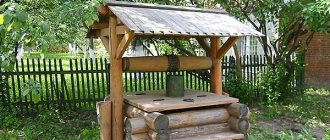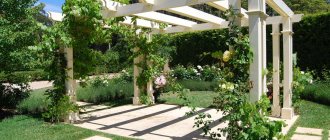Filled with majestic harmony, landscape design in the English style not only does not lose over time, but on the contrary, it becomes increasingly relevant and, accordingly, in demand. Being for many a standard of excellence and a source of inexhaustible inspiration, it turns any estate into the surroundings of an ancient castle. Against the background of apparent simplicity and naturalness, refined artistic taste, respectability and aristocratic luxury are visible in everything.
Common features
The appearance of a traditional English-style garden continues to be an example of landscape art for many. The described direction was formed to create an alternative to the regular French park. At the end of the eighteenth century, many were already tired of the geometrically correct layout, which had pronounced symmetry with straight alleys, parterres and ponds. It was impossible to be too distracted from the theme of classicism at that time; his ideal paintings were in fashion. But society was tired of the effect of man’s absolute control over nature, so the idea of creating a park appeared, which outwardly looked like a man-made natural extension of the surrounding landscape.
The beauty of nature within the framework of man-made processing Source standard.co.uk
The creators of such creations sought a balance between interference with natural nature and its unbridled temperament. Therefore, the new trend was based on the principle of the element of unpredictability. Walking through such a park, a person did not know what awaited him around the bend of the alley. To realize such aspirations, a variety of picturesque elements were used (small bridges, pavilions, fountains, flowerpots, pyramids, decorative structures stylized as ruins).
Gardens in the style described have an amazing sense of proportion; they look noble and picturesque. Their aesthetics are highly functional. The principles of its construction are considered unshakable. They can be used by anyone who dreams of creating a small green corner in the style of old England in their dacha. To do this, you must adhere to the following rules.
Lush noble beauty Source pinterest.com
Basic structure
An English garden in landscape design is an object with a clearly planned structure. Its basis is walking areas, the routes of which allow you to observe the change of decorative objects. Their selection is strictly limited. The generally accepted ones are:
- large green lawn ;
- front garden;
- open light gazebo in the form of a pavilion;
- a garden created from fruit or ornamental trees;
- picturesque pond .
All these zones are separated from each other by walls made of stone, reminiscent of ancient ruins, or by impeccably trimmed green fences. When placing the listed objects, it is necessary to adhere to strictly defined boundaries.
Stone walls in a classic garden Source yandex.ru
The space between the decorative inserts is united by routes intended for walking. They are formed using paved paths or soft paths sprinkled with gravel. Along them you can plant flower beds and make ridges. You can complicate the task and place them inside green boxwood labyrinths. The business card of landscape design in the style of an English park is one-sided or two-sided mixborders.
English gardens: history
The first steps in the development of gardening in England were made by Christian monks, back in 1066–1500. Then the gardens were set up to grow vegetables, fruits and medicinal herbs, there were also flowers, however, the main function of the garden was to provide the owner with food. The people were finally formed as a nation, the cities were sparsely populated, residential buildings were surrounded by picturesque fruit and vegetable gardens and farms.
In the century of the outstanding scientist Caxton (15th century, 1422-1491), who printed about 100 books on his press, a form of the English language was established, combining several different dialects. The printing press influenced the development of science and culture as a knowledge multiplier. Education developed and spread.
The first book on gardening, authored by John Gardner, was written and published in 1450, it described more than 80 types of flower and vegetable crops. Only a few types of flowers were grown in the gardens: lily of the valley, rose, iris and mallow.
Active development of landscape design
During the reign of King Henry the Eighth (1509–1557), landscape design began to be given special attention, and symmetry was valued in the decorative arts. Towards the middle of the 16th century, the garden acquired flower beds, group plantings, terraces, topiary shrubs and alleys with wicker vaults. Thus, the Tudor garden was born.
Symmetrically located paths led through the garden, and trimmed evergreen bushes served as a fence. The green spaces of the garden were decorated with metal sculptures, mainly figures of Greek goddesses, nymphs or animals.
Reign of Queen Elizabeth (1558-1603)
Many plants new to England were imported from other countries; this was facilitated by the rapidly developing trade relations between England and the outside world. Gardening also saw some changes; a flower garden appeared, divided into square and triangular zones with wide paths.
During the reign of the queen, various aromatic herbs were actively grown in the gardens - rosemary, thyme and lavender, the latter was even used to make hedges by cutting it. Lilies and gillyflowers were also bred. Walking through the garden was accompanied by the singing of birds, cages were hung on tree branches, and the garden was decorated with fountains, figures in the shape of animals and sundials. Curly cutting of plants has reached the peak of popularity. Yew, juniper and rosemary were given different shapes.
The reigns of James the First (1603-1625) and Charles the First (1625-1649)
The love of flower gardens has become a characteristic feature of the British. Dutch refugees who settled in England brought with them new plants, these were tulips, nasturtiums, nigella damask, tulip tree, moonberry, red maple, etc.
During this period, the science of botany was actively developing, the nuances of growing trees and protecting nature from smoke and other harmful factors were studied. Biology also began to progress with the advent of the microscope. The study of the cellular structure of plants began and the secret of their reproduction was revealed. The first hybrid plants appeared.
Towards the end of the 17th century, the British became interested in growing exotic plants, such as oranges, and this is how greenhouses appeared, which today occupy a significant part of the area in the vicinity of London.
In the 17th–18th centuries, Andre Le Nôtre, an architect and creator of famous gardens in many countries, introduced the idea of planting flowers, trees and shrubs in a geometric order; the garden was divided into huge, lush and pompous open-air rooms. But English gardeners considered this idea not the most successful, because the gardens seemed monotonous and artificial. The British gradually gave the gardens a freer layout.
Le Nôtre’s ideas that did not take root were replaced by new directions announced by the next generation of landscape designers Lancelot Brown, Humphrey Repton and William Kent. Now vegetation had become the defining element of the garden, straight planting lines, symmetrical ponds were no longer considered appropriate in garden art, and straight paths were replaced by winding ones.
English landscape design is a truly English art, it does not contain gardening ideas from other countries, they simply did not take root, its creators expressed their personal views on the beauty of nature. The design of garden plots was on a considerable scale, lawns were planted, dams were built on rivers, lakes were developed, forests were planted, the law of harmony was taken into account - the combination of different trees by type and size, for example, a deciduous tree was planted next to an evergreen one.
A border and lawn made of annual herbaceous plants is an element of landscape design invented by English gardeners.
Seeds and bulbs of plants brought to England were delivered to nurseries, the first of which belonged to George London, the owner of the second nursery was Philip Miller. Later, an experimental garden was founded at the Royal Horticultural Society in 1818, where plants were grown for sale.
Industrial Revolution of England (early 19th century)
This event could not but influence the art of garden design, since the influence of aristocrats - landowners passed on to industrialists, merchants, and bankers. The Victorian period saw the emergence of the middle class as the foundation of modern English society. Private park areas and huge gardens became unaffordable for landlords; they were replaced by a small garden.
Further, the gardening art of England developed as rapidly as before, plants were exported and imported, new ideas and solutions appeared. Nowadays, there are clearly formed features inherent in an English garden or park. It is worth noting that thanks to the nature of England, gardens are mainly designed in landscape style.
Style elements
Despite the fact that the natural beauty of nature is at the forefront, the garden described can only be called as close to natural forms as possible only conditionally. In its implementation one can always feel the experienced hand of a gardener with a capital G. Therefore, the overall picture includes trimmed fences and well-mowed lawns. Free landscape plantings fill the empty areas that remain after identifying the main accents (promenade alleys, architectural elements, green labyrinths).
Romantic corner in the garden Source roomester.ru
The garden in England imitates not pristine nature, but a pastoral picture in which a fairy-tale atmosphere dominates. Branched thickets and overgrown bushes are not for the object being described. There is only room for perfectly trimmed corners. All accents used should emphasize aristocratic luxury and resemble the appearance of a colorful postcard prepared for an art exhibition.
Classics within classics – that’s what landscape design is in English. If shrubs are needed, then boxwoods should act as them. If you need to plant trees, it is better to use maples, catalpas or wild apple trees. Their favorite partners are catnip, heuchera and delphinium. The lower tier is most often decorated with lavender and veronica. Bulb plants (tulips, muscari and daffodils) look good in such splendor. For several centuries in a row, this combination has not gone out of fashion. All together, they don't look boring.
The principle of multi-tiered design Source pinterest.es
Each designated plant has its own distinct personality. If you can choose them taking into account shapes, sizes and colors, you will be able to accurately recreate the style of an English aristocrat.
Greens in a plane
The color of lush greenery always dominates the gardens of England. You can’t do without a lush lawn. It unifies the overall composition, serves as its main background, fills the resulting bald spots and balances the flower beds. Without the use of such a technique, it is impossible to achieve natural harmony and create the splendor of charm.
Emerald-colored base for framing perennials Source pinterest.com
See also: Catalog of companies that specialize in landscape design of sites.
If you want to organize something similar on your personal plot, you need to make strict lawns, create a border of greenery around ponds, connect or ridges and create walking routes. The lawn should become a backdrop for admiring everything that is in landscape gardening.
A scientific approach to plant selection
Despite the fact that the English style in landscape design implies the creation of zones of equal importance, the basis for the success of the general idea is that the choice of plants should be carried out on a strictly individual basis. The owner is obliged to know everything about each of them: the nuances of planting, care, reproduction.
There is no way to save time in this matter. Therefore, it is advisable to start a separate journal and compile catalogs in it, describe the stages of work for each specific species, build schedules for watering and fertilizing, tillage, weeding and resettlement. The garden will have to dedicate itself to itself and constantly look after it, like a small child. It is important to do this thoroughly, using a scientific approach, constantly studying the experiences of other gardeners and communicating with them on forums. This approach will make it easy to adjust existing ensembles.
A well laid out flowering garden Source pinterest.com
Color balance
Harmony in color is another basic principle. The ability to achieve it and then maintain the garden in the required form at any time of the year is a task for professionals. There is nothing complicated about this if you know how to build a color scheme. Here you need to act like a skilled artist: take a basic foundation and, starting from it, skillfully use different shades.
The described garden does not have faded colors, contrasts or boring undertones. Aristocratic landscapes are those in which a calm green palette dominates; every colorful and rich element has its own counterbalance, and every light color is adjacent to a dark, rich, deep tone. When compiling a range, you need to use a combination of shades that are adjacent to each other. For example, it is good to mix purple with lilac, yellow with orange, blue with cyan.
The nuances of designing a site in the English style
To achieve the most English look in a park area, it is necessary to avoid overly spreading borders. Preference is given to classic geometric shapes: square, rectangle, circle or oval. Another important detail in the design is minimalism in the choice of plants. It is better to use 2-3 types of greens of different shades.
Thanks to this approach, it is possible to simultaneously achieve a large palette of colors and tranquility of the relaxation area. Using the same material for different objects will make the estate harmonious. For example, a house, a fountain, or garden walls trimmed with stone transform the picture into one whole.
If you also plant annuals in addition to other plants, you will be able to admire the flowering for longer – about 4 months. Such representatives of the flora can be placed in the center of flower beds or along the edges, or even in paths.
Video description
The video shows how the English Garden Museum was created in London, where purely English landscape design is presented:
Water sources
In English parks you can find small springs, small fountains, and well-groomed ponds. All of them have high decorative functions, and they can be used for watering plants.
A pond with a stepped waterfall in a luxurious green frame Source yexplore.travel
Solving such elements requires serious material investments. The size of the reservoirs should be impressive, the banks should be high, and the plants should be planted in large groups.
Careful care
A garden in the spirit of good old England should be surrounded by great love. This style is best suited for those who like to tinker with plants: pruning roses, mowing green lawns. Everything needs careful care, you have to put your soul into everything. Therefore, such a creation will not suit lazy people. Even one neglected bush, a withered bud, a dry shoot will immediately destroy the splendor created by your hands. And there can be no talk of weeds. So careful care is another principle of creating English design.
Design and decor
Little man-made decor is used in English parks and gardens. However, those decorations that are still present in the landscape automatically become accent zones, precisely because they are in the minority and are greatly outnumbered by green spaces. The location of important decorative details should be thought out in advance. The designer arms himself with a sheet of sketch paper and a pencil, sketches out a site plan, then applies existing buildings to the drawing. Now that it’s easier to navigate the area, you can draw an approximate layout of the decor. From the wide range of landscape decorations, you should choose only typical English or antique details. The latter are used to decorate individual secluded corners of the property.
Decorative structures
In the design of English plots, two types of materials prevail: wood and stone. The first is used for making benches, fences, and gates. The lower part of the facades of buildings is finished with stone, monumental fences are erected from it, and paths are paved. The fence can also be made of brown brick, but it must be supplemented with forged elements so that the structure does not look faceless. Decorative structures include pergolas, gazebos, benches, sculptural compositions, platforms up to half a meter high. The relief of the site is emphasized by stone stairs. Their steps are decorated with moss, and lushly growing mixed borders are planted on the sides. As a rule, each garden has its own corner for privacy. It is installed near a pond or on the border of a site away from a noisy courtyard.
In the center of such a site, surrounded by benches, a gazebo or statue depicting a person or animal is placed. Decorate the area with greenery or a low fence. By the way, benches are located under trees, along garden paths or near ponds. Pergolas are usually placed directly on the road, that is, support pillars are dug into its sides. In the summer heat, this zone will give those walking around the site much-desired shade. Garden furniture is made of wood with forged elements. It is desirable that the items belong to the Baroque, Art Nouveau or Empire style. The peculiarities of the English landscape include such an unusual decoration as the “wooded theater”. It is formed in the most remote part of the site. A small area is set up in the center of wild trees. It is decorated with statues, columns, a fountain, trimmed bushes, and benches. Thanks to these elements of the ancient style, it seems as if a full-fledged structure once stood here, of which only beautiful ruins remain. The lighting fixtures chosen are classic: black lanterns on thin, high legs, decorated with openwork shades that emit soft, diffused light.
Cottage garden areas are often decorated with pavilions or greenhouses. These are compact structures, most of which are occupied by windows. Tender exotic plants are grown inside and furniture (chairs, sofa, table) is placed. People relax in the pavilions, hold tea ceremonies, greet guests, read books and do handicrafts.
Paths
Paths, as a rule, are made of two types of materials. Those closer to the house are paved with stone, since people walk in the yard more often, which means the load on the pavement increases. The “veins” of moss that fill the voids between the fragments of the paved surface will look beautiful. Then the path will take on a careless and slightly “abandoned” look. The stone goes well with picturesque, dilapidated brick walls, the gaps of which are entwined with hops or ivy. Paths hidden in the depths of the site are sprinkled with gravel, crushed stone, sand or crushed bark. If coniferous trees grow in the garden, then the passage under them can be filled with cones. This option looks very original.
Reservoirs
English-style ponds have an irregular shape that imitates natural contours. The gently sloping bank is decorated with plants. A small fountain or sculpture is placed in the center of the reservoir. The water surface is decorated with water lilies, lilies, and duckweed. If the dimensions of the reservoir allow, then a bridge with forged railings is thrown across its middle. Be sure to place one or two benches near the water. I partially decorate the shore with stone steps, which smoothly turn into a rock garden, and large cobblestones.
Generalization on the topic
An English-style garden is an artistic creation. This direction is very popular. But in order for its splendor to please the eye throughout all four seasons, special careful care and a scientific approach to the formation of plant groups are needed. Inside such an object, everything is lined up in the correct geometry, but it is visible only from a great height. Inside, everything is mysterious and laconic. Around every turn there is a new surprise in the form of an antique sculpture near a waterfall or a wicker bench hidden in a well-groomed flower garden. All these objects are connected by paved paths.
Ratings 0
Practical recommendations for the project
Planning a sketch of the territory should begin with thinking through the paths. The main rule of such work is not to forget that paths are needed not for quickly covering the territory, but for enjoying the walk. They must always branch out and then meet again in unusual places.
The beginning of all paths should be a house that also matches the style of the garden. If the building was already built before the idea of creating the English style appeared, then the following will help make the look harmonious:
- Replacing the roof with tiles;
- Covering the facade with climbing plants;
- Cladding the outside of the house with natural stone or red brick;
- Complete replacement of windows with those with frames or gluing of false frames.
Paths
Paths must be designed so that they can be navigated comfortably. For this, it is better to choose gravel, flat sandstone or cobblestones. Paths should not be wide.
Lawn
Since your lawn will not have a “no walking on lawn” sign on it, it is recommended to choose grass that will not be easily trampled. Of course, it should always be neatly trimmed. Large boulders will fit well into the design of the park area.
Water
The main rule in creating a reservoir is naturalness. To achieve this effect, the banks must be slightly overgrown. Willow, stones covered with moss and other pond greenery go well with such a stream or pond.
Rest zone
Zones within the park are separated from each other using small stone or sandstone supporting walls or hedges. A good design solution would be a gazebo that is located away from prying eyes. It can be entwined with wild vineyards or fragrant hops.
Often in English films you can see a girl sitting on a bench and admiring nature against the backdrop of some lake. This is very typical for this style. Therefore, in the most comfortable beautiful areas, you can safely install antique benches.
Plants
The optimal solution when choosing plants is to use those that are adapted to the climate of the area. The most commonly planted trees are larch, maple, chestnut, rowan and spruce. It looks very impressive when a massive spreading tree is planted in the center of a wide lawn, which can be admired from different points. Most often oak is used for this. But you can also choose birch, pine, spruce or maple.
An important part of the garden are shrubs. They are planted near trees, like a fence, and separately throughout the territory. To do this, it is recommended to choose shadberry, lilac, forsythia, hydrangea, barberry or mock orange. Climbing plants include wild grapes, ivy or hops. The park area will not correspond to the image under discussion if there are no bright flower beds with roses, peonies, daylilies, and phlox near the house.
An excellent solution would be multi-tiered plants along the paths. For the bottom row of such mixborders, primroses, anemones, speedwells, and cuffs are recommended. For the average – hostas, columbine, ferns. For the tallest - sage, delphinium, mallow.
Sculptures and architectural decoration
It is necessary to install an antique sculpture of an aged type as deep as possible in the estate. You can also safely place a sundial, a wooden or stone bridge over a pond, as well as dilapidated stone walls.
Plant selection: flowers, shrubs and trees
The green background on which flower beds and rock gardens are located will be hops, clematis, ivy and maiden grapes. Climbing plants literally cover the walls of not only the main building, but also the adjacent buildings. Spices bloom wildly in English gardens. Choose from a variety of tarragon, bay, turmeric, saffron, basil, rosemary, wild garlic, cloves, coriander and parsnip. The edges of reservoirs are decorated with swimsuit, cattail, marigold, forget-me-nots, irises and sedge. Among the trees, preference is given to chestnut, rowan, larch, birch, oak, thuja and hazel (hazel).
Bushes of euonymus, turf, mock orange, lilac, elderberry and jasmine are planted along the perimeter of the site. Among the variety of perennials, the choice is roses, phlox, common wormwood, giant onions, ferns, bergenia, rhubarb, columbine, hostas, and Rogers. The cottage garden uses spirea, daisies, crocuses, galanthus, lilies of the valley, elecampane, delphiniums, peonies, primrose, and asters. Among flower beds, preference is given to slightly sloppy mixborders. Neat single flower beds near the house itself are placed in stone bowl vases on high, thin legs.
Don't forget about rockeries and rock gardens. They are an important part of the English garden, as they highlight its natural beauty.











